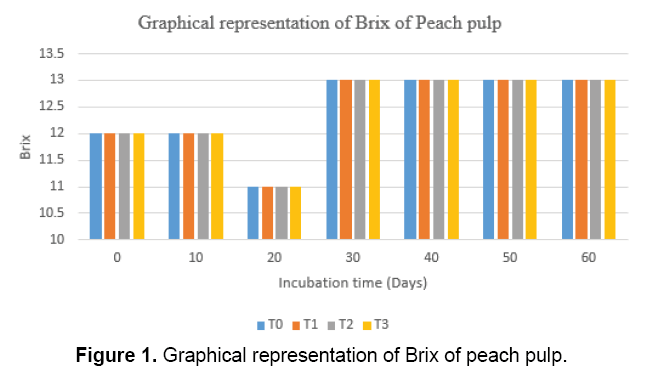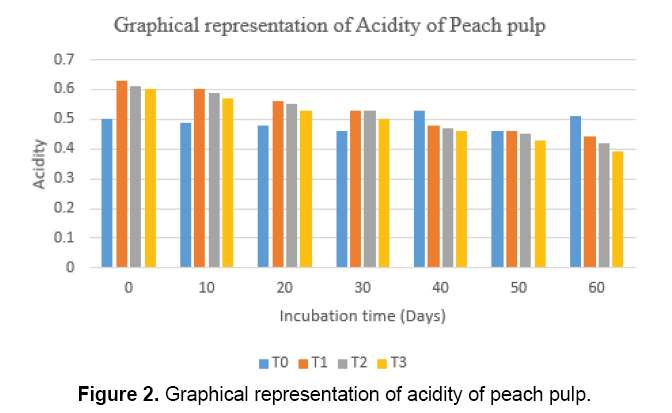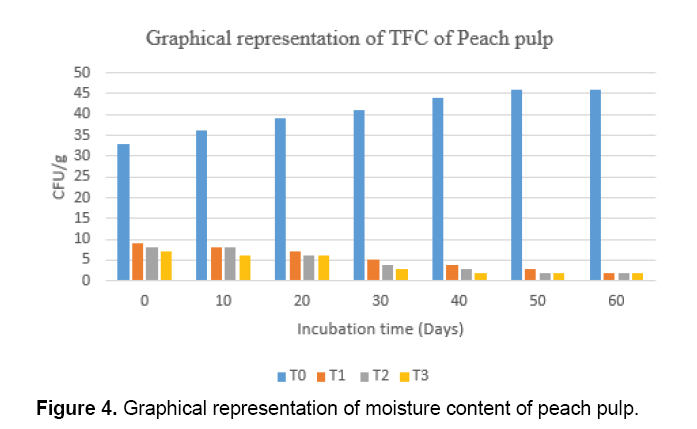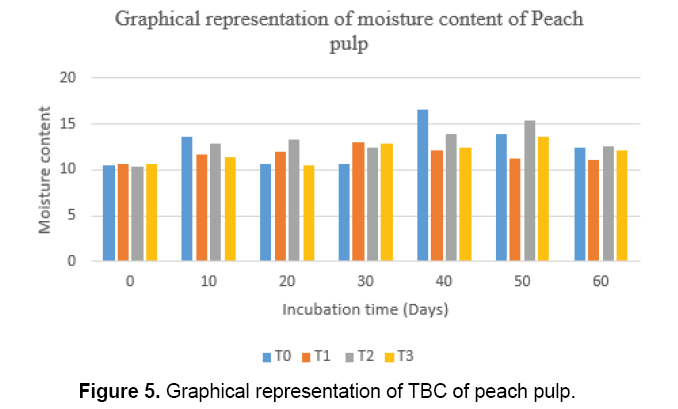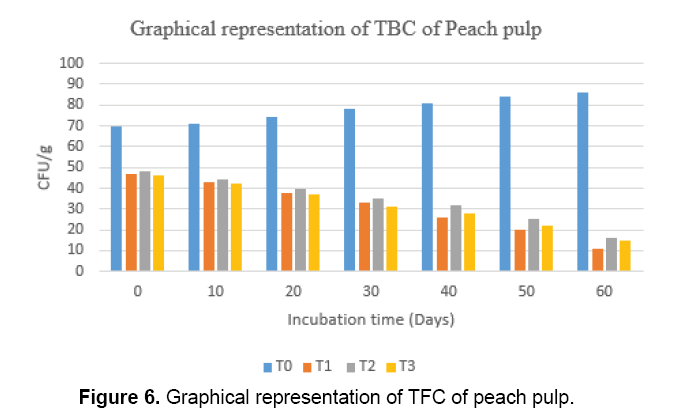Strategies to Combat Microbial Food Spoilage Activities in Peach Pulp
Abdul Razzaq, Asad Imtiaz, Muhammad Awais Junaid, Muhammad Masood Qureshi1, Arif Malik, Arfan ali, Mahmood Hussain Qazi, Nasir Mahmood
1Institute of Molecular Biology and Biotechnology, The University of Lahore, Pakistan;
2Four Brothers Group, Private Limited, Pakistan.
- Corresponding Author:
- Abdul Razzaq
Institute of Molecular Biology and Biotechnology
The University of Lahore, Pakistan
Tel: 0923314098481
E-mail: Abdul.razzaq@imbb.uol.edu.pk
Received date: November 16, 2017; Accepted date: December 26, 2017; Published date: December 30, 2017
Citation: Razzaq A, Imtiaz A, Junaid MA, et al. Strategies to Combat Microbial Food Spoilage Activities in Peach Pulp. Electronic J Biol, 13:4
Abstract
Peach is a perishable fruit with shelf life of few days at natural environment that can be extended for weeks under refrigerated conditions. The chemical preservation of peach pulp is the best method for extending its shelf life and retaining its quality. In this research work Peach pulp was stored at 40°C to check the combinatorial effect of chemical preservatives (Sodium Benzoate and Potassium Metabisulphite). Freshly matured Peach fruit was taken for this research. The pulp was extracted and preservatives were added. The concentration of SB and PMS of 1 mg/g were used. The physicochemical properties (TSS, pH, Acidity and moisture) and Microbial growth of the pulp were studied for 60 days after the regular interval of 10 days. The combination of preservatives at concentration 1000 ppm is very effective in limiting the microbial growth. The physicochemical properties of pulp were greatly affected with addition of chemical preservatives. Increase in pH was observed with respect to decrease in acidity after 60 days. It was concluded that combinatorial use of these preservatives in Peach pulp significantly supported in retaining quality of Peach pulp for 60 days storage.
Keywords
Peach; Chemical preservatives; Microbial analysis of pulp; Chemical analysis.
Introduction
Peach is one of the most important stone fruit, its botanical name is (Prunus persica (L.) Batsch). Peach is believed to be the queen of fruits. Its roots were found in the region of Northwest China between the Tarim Basin and the north slopes of the Kunlun Shan Mountains [1]. Later peach was carried to Western Asia and Subcontinent, from there peach was migrated to Europe when Alexander. The Great conquered Persia [2]. There are two important varieties of peaches grown worldwide Cling and Free Stone. An average peach consists 85-88% water and 5% dietary fibers. It also consist 18% of sugar, 2% protein and vitamin A 11%, B1% and C 5% (USDA SR-21). China is the pioneer for production of peach it hold worlds 54% production. According to French Ministry of Agriculture and the Statistical Division (FAOSTAT) of the Food and Agriculture Organization of the United Nations (FAO) the worlds peach production was increased in recent years, e.g. China the net production of peach was 11012747 tons but in year 2014 it jumped to 12452377 tons. This was due to introduction of new breeds or many farmers were encouraged for cultivation of peach. Due to suitable atmospheric conditions in Pakistan, Pakistan was ranked 6th on production of peach in year 2014, peach was cultivated on an area of 6,330 hectares and its net production was 36,155 tons. KPK is leading province in Pakistan for production of peach with 32028 tons then comes Baluchistan with 21028 tons and on last Punjab with 170 tons (Ministry of National Food Security and Research, Government of Pakistan).
Peach plays an important role in daily life; it is used for production of jams, jellies or fruit drinks, yogurt, icecreams and other dairy products (TECH). Peach also plays a vital role in cosmetic for production of facial mask, sunblock’s. Peach seed consists of Laetrile. It is studied that the Laetrile plays an important role in treatment of cancer (Laetrile/Amygdalin (PDQ): Health Professional Version), peach seed also plays a vital role in relief in constipation (Healing with Whole Foods: Asian Traditions and Modern Nutrition).
Being a perishable fruit peach has an average shelf life of about 4-5 days at ambient temperature. Storing the fruit in cold conditions will slow its metabolism and it can last up to 15-20 days. As the season of peach stays for about 2 months it has to be preserved for future use.
Peach has a shorter life span due to rapid spoilage by microorganism present in air. Microorganisms degrade it by causing a browning effect of Maillard reactions, which also incite the ingesting of reducing sugars and the creation of 5-hydroxymethyl furfural (HMF) and sucrose hydrolysis. Amino acids play an indispensable role in browning reactions and softening as they react directly with the reducing sugars, triggering a chain of complex reactions generating brown pigments known as melanoidins [3]. There are two main methods for food preservation or extending the fruits shelf life, one is physical method which mainly includes drying and storing fruit at dry place, this method is not reliable as there is a chance of microbial attack because microbes are all over in the air which leads to food spoilage. The second is chemical method; it is an effective and long-lasting method as compared to physical. In chemical preservation different chemicals are added to increase the shelf life of food, remember the chemical should be food graded and that it does not cause any effect on human health. There are number of chemicals used for extension of shelf life, mainly sodium benzoate, potassium metabisulphite, sodium sorbate, sorbic acid, sulphur dioxide, sodium propionate. There are several factors which are seen before choosing the preservatives which include the chemicals we have selected should be regarded as safe, it must not affect human health and must be a cost effective compound. After addition of chemicals in food, quality and morphology of overall food should remain intact. Generally regarded as safe range of chemical lies between 0.15-0.25% whereas sodium benzoate and potassium metabisulphite which are used more often have range of 0.1%.
Sodium Benzoate and Potassium Metabisulphite are commonly used preservatives because these both show better resistance against different types of bacteria [4-6]. Some yeast strains, Spoilage organisms and food poisoning are well controlled by Sodium Benzoate [7]. Different experiments were designed with increasing concentration to check antimicrobial effect. It was defined that with these concentrations of sodium benzoate most of the species of Aspergillus were in control [8-10]. In codex standard of 2001 and 2006 it is labeled that the standard usage of Sodium Benzoate is 1000 mg/Kg and Potassium Metabisulphite is 500 mg/Kg, incorrect or overuse of these or other preservatives can lead to negative effect on human heath [11]. This can also lead to development of resistant in bacteria against these chemicals and cause foodborne diseases [12-14].
Materials and Methods
Collection of fruit sample
Mature and fresh Peach fruits were sampled from the local market under standard conditions. The fruit seemed even in color, size and weight. Distilled water was used to remove the unwanted dust from the exocarp of the fruit. Potassium metabisulphite (K2S2O5) and sodium benzoate (NaC6H5CO2) were purchased form (SIGMA-ALDRICH).
Pulp formation
Before extraction of fruit pulp the fruits were washed with distilled water and air dried. By using the stainless steel knife the seed (endocarp of the fruit) was removed, leaving behind exocarp and mesocarp which were passed through the Electronic Pulper (National model no# JPN176, made in Japan) for the formation of pulp.
Pasteurization of pulp
The pulp was collected in a volumetric flask for its pasteurization. Pulp pasteurization was carried out for 30 min in a water bath at 83°C, following the method opted by Hussain et al. [15].
Treatment of pulp with preservatives
As the temperature of pulp decreased to room temperature the preservatives (Sodium benzoate and PMS) at different concentrations were added collectively under aseptic conditions. After treatment with preservatives the pulp was poured into 21 sterilized test tubes each containing 20 ml of pulp labelled as T1, T2 and T3 and 7 tubes were kept without preservatives as control (labelled as T0). All these test tubes were covered in aluminum foil and were stored at 40°C for 2 months. The microbial growth, pH, acidity, total soluble solids (Brix) and moisture content were assessed and evaluated after a gap of 10 days.
Microbiological stability of pulp
Culturing of stored samples was conducted in order to examine the bacterial and fungal counts. 100 μl of stored pulp was pipetted and spread on to the petri plates using a spreader under aseptic conditions. Petri plates were incubated at 37°C for 24 h. In order to determine the bacterial count of chemically preserved Peach pulp Muller Hinton agar was selected as nutrient source and for fungal count Potato Dextrose Agar was selected. The results were calculated and recorded as CFU/g.
Physicochemical analysis of pulp
pH meter (Inolab® model no # WTWPH7110, made in Germany) was used to determine the pH. To determine the total soluble solids in the pulp, refractor meter (SG model no# Abbe-2WAJ, made in China) was used. To confirm the acidity, titration of a 0.1 N solution of NaOH was used. Moreover, moisture was determined as Loss on drying (LOD) at 105°C for 2 h.
Results and Discussion
Physicochemical analysis of peach pulp
The purpose of this study was to determine the combinatorial effect of preservatives (PMS and SB) in maintaining the physicochemical properties of incubated peach pulp for 60 days (Table 1). Different concentrations of preservative were used in combination. This research concludes that the chemical preservation had great influence on physicochemical properties of peach pulp.
| Treatment | Sodium benzoate (mg/g) | Potassium Metabisulphite (mg/g) |
|---|---|---|
| T0 | - | - |
| T1 | 1 | 1 |
| T2 | 1.5 | 1.5 |
| T3 | 2 | 2 |
Table 1: Treatment combination (mg/g).
On day zero the brix did not change. After 60 days of storage, the brix increased shown in Figure 1. This increase in Total Soluble Solids with the passage of time can be due to solubilization of fruit constituents during storage [16]. The change in acidity on initial day was observed as shown in Figure 2. Change in pH was recorded in samples that were treated with preservatives on day zero (Figure 3). No significant effect was detected upon moisture content by preservatives on initial day (Figure 4). Physiochemical properties of chemically preserved peach pulp changed between 60 days of storage time. Increase in brix, pH and moisture content was observed during storage period. Increase in the acidity was observed in the stored peach pulp which was treated with combination of preservatives. This study depicted an increase in the acidity on the first day of preservative addition in Peach pulp and during storage period of 60 days (Figure 2).
There is an increase in total soluble solids (TSS) with the passage of time (Table 2). Peach consists mainly of glucose, fructose and sucrose. After an interval of storage time peach started to ripen up, sucrose is broken down by polyphenol oxidase and converted into the soluble sugars which give rise in the total sugar content [17].
| Treatment | Days | Mean | ||||||
|---|---|---|---|---|---|---|---|---|
| 0 | 10 | 20 | 30 | 40 | 50 | 60 | ||
| T0 | 12 | 12 | 11 | 13 | 13 | 13 | 13 | 12.4 |
| T1 | 12 | 12 | 11 | 13 | 13 | 13 | 13 | 12.4 |
| T2 | 12 | 12 | 11 | 13 | 13 | 13 | 13 | 12.4 |
| T3 | 12 | 12 | 11 | 13 | 13 | 13 | 13 | 12.4 |
| Mean | 12 | 12 | 11 | 13 | 13 | 13 | 13 | |
T0=control, T1=1000 ppm, T2=1500 ppm, T3=2000 ppm (SB and PMS)
Table 2: Treatment and storage effect of preservatives on TSS (Brix) of peach pulp.
On initial day the brix of peach pulp was low as on the day of extraction the peach was not completely ripe. With the passage of time the brix of stored pulp increased as compared to other researches [15,18]. This increase in brix was due to solubilization of fruit constituents during storage time [16]. Same results were reported by researcher in custard apple pulp [19]. If the fruits are not entirely ripe and passed for pulp extraction they will have insignificant levels of ethylene in the improved environment with addition of chemical preservatives. The process of ripening will be delayed due to reduction of metabolic processes and respiration.
This proposed study depicted that there was an increase in acidity of the stored peach in treated samples over a period of 60 days (Table 3). These results do agree with other researchers who confirmed the increase in apple pulp during storage up to 90 days at ambient temperature [20]. Acids are responsible for the acidity in fruits. By degradation of polysaccharides, pectic substances and uronic acid [20,21]. Oxidation of reducing sugars also plays major in elevating the acidity in fruits [22].
| Treatment | Days | Mean | ||||||
|---|---|---|---|---|---|---|---|---|
| 0 | 10 | 20 | 30 | 40 | 50 | 60 | ||
| T0 | 0.50 | 0.49 | 0.48 | 0.46 | 0.53 | 0.46 | 0.51 | 0.49 |
| T1 | 0.63 | 0.60 | 0.56 | 0.53 | 0.48 | 0.46 | 0.44 | 0.52 |
| T2 | 0.61 | 0.59 | 0.55 | 0.53 | 0.47 | 0.45 | 0.42 | 0.51 |
| T3 | 0.60 | 0.57 | 0.53 | 0.50 | 0.46 | 0.43 | 0.39 | 0.49 |
| Mean | 0.585 | 0.562 | 0.530 | 0.505 | 0.485 | 0.450 | 0.440 | |
T0=control, T1=1000 ppm, T2=1500 ppm, T3=2000 ppm (SB and PMS)
Table 3: Treatment and storage effect of preservatives on total titratable acidity of peach pulp.
On first day the preservatives exhibited no effect on pH of peach pulp. But during the storage of 60 days the preservatives increased the pH of pulp. Whereas, in controlled samples there was a gradual increase in pH (Table 4). PH plays an important role in enhancing the flavor and stabilizing the fruit pulp. These results of increasing pH agreed with Hussain et al. [15] and Cepeda et al. [23]. who detected and explained the increasing pH in orange with passage of time.
| Treatment | Days | Mean | ||||||
|---|---|---|---|---|---|---|---|---|
| Initial | 10 | 20 | 30 | 40 | 50 | 60 | ||
| T0 | 4.30 | 4.00 | 4.60 | 5.30 | 5.30 | 5.30 | 4.70 | 4.78 |
| T1 | 4.30 | 4.40 | 4.80 | 5.20 | 5.40 | 5.70 | 5.80 | 5.08 |
| T2 | 4.30 | 4.5 | 4.7 | 4.9 | 5.2 | 5.3 | 5.5 | 4.91 |
| T3 | 4.30 | 4.4 | 4.6 | 5.0 | 5.3 | 5.6 | 5.9 | 5.01 |
| Mean | 4.30 | 4.32 | 4.67 | 5.1 | 5.3 | 5.47 | 5.47 | |
T0=control, T1=1000 ppm, T2=1500 ppm, T3=2000 ppm (SB and PMS)
Table 4: Treatment and storage effect of preservatives on pH of peach pulp.
At first day the addition of preservatives lead to no change in moisture content of stored peach pulp. The moisture content of treated samples explains that the preservatives lead to constancy of peach pulp where in controlled samples variation was noticed (Table 5). In open environment the fruit pulp is very delicate as it contains high moisture content due to which the shelf life of pulp decreases and pulp can be easily spoiled by microbes.
| Treatment | Days | Mean | ||||||
|---|---|---|---|---|---|---|---|---|
| 0 | 10 | 20 | 30 | 40 | 50 | 60 | ||
| T0 | 10.48 | 13.57 | 10.60 | 10.69 | 16.57 | 13.97 | 12.49 | 12.62 |
| T1 | 10.58 | 11.74 | 12.00 | 12.98 | 12.20 | 11.20 | 11.09 | 11.68 |
| T2 | 10.38 | 12.88 | 13.37 | 12.50 | 13.95 | 15.36 | 12.58 | 13.00 |
| T3 | 10.62 | 11.36 | 10.55 | 12.90 | 12.46 | 13.67 | 12.20 | 11.96 |
| Mean | 10.51 | 12.38 | 11.63 | 12.26 | 13.79 | 13.55 | 12.09 | 12.31 |
T0=control, T1=1000 ppm, T2=1500 ppm, T3=2000 ppm (SB and PMS)
Table 5: Treatment and storage effect of preservatives on moisture content of peach pulp.
Total bacterial count (TBC)
The inhibitory action of preservatives upon the bacterial growth in peach pulp increased with passage of time. The bacterial growth was restricted as less than 50 CFU/g on the initial day to 60th day with use of preservatives (Table 6). It is clearly revealed in Figure 5, the active role of preservatives in peach pulp during the storage duration. However the use of these preservatives in combination did not entirely inhibit the bacterial growth from the pulp during the storage time of 60 days. Large number of bacterial colonies was seen in the control samples which increased with passage of time as shown in Figure 5. As stated by Hussain et al. [15] and Saeed et al. [24] on inhibitory effect with different concentrations of preservatives (1 mg/g SB, 1 mg/g PMS, 0.5 mg/g SB, 0.5 mg/g PMS) revealed controlled effect on microbial growth.
| Treatment | Days | Mean | ||||||
|---|---|---|---|---|---|---|---|---|
| 0 | 10 | 20 | 30 | 40 | 50 | 60 | ||
| T0 | 70 | 71 | 74 | 78 | 81 | 84 | 86 | 77.71 |
| T1 | 47 | 43 | 38 | 33 | 26 | 20 | 11 | 31.14 |
| T2 | 48 | 44 | 40 | 35 | 32 | 25 | 16 | 34.28 |
| T3 | 46 | 42 | 37 | 31 | 28 | 22 | 15 | 31.57 |
| Mean | 52.72 | 50.00 | 47.25 | 44.25 | 41.75 | 37.75 | 32.00 | |
Table 6: TBC.
Total fungal count (TFC)
The treated samples showed decrease in fungal growth whereas controlled samples showed increase in fungal growth with storage time. The use of preservatives with combinations efficiently restricted the fungal growth as less than 50 CFU/g on the first day to 60th day (Figure 6 and Tables 6 and 7).
| Treatment | Days | Mean | ||||||
|---|---|---|---|---|---|---|---|---|
| 0 | 10 | 20 | 30 | 40 | 50 | 60 | ||
| T0 | 33 | 36 | 39 | 41 | 44 | 46 | 46 | 40.71 |
| T1 | 9 | 8 | 7 | 5 | 4 | 3 | 2 | 5.42 |
| T2 | 8 | 8 | 6 | 4 | 3 | 2 | 2 | 4.71 |
| T3 | 7 | 6 | 6 | 3 | 2 | 2 | 2 | 4.00 |
| Mean | 14.25 | 14.50 | 14.50 | 13.25 | 13.25 | 13.25 | 13.00 | |
Table 7: TFC.
Conclusion
The proposed study verified the combinatorial impact of Sodium Benzoate and Potassium Metabisulphite on microbial growth and physicochemical properties of peach pulp stored at 400°C in dark conditions for 60 days. It is concluded that the preservatives (SB and PMS) applied in combination at different concentrations of 1000 ppm, 1500 ppm and 2000 ppm each were greatly effective in restriction of microbial growth and keeping the peach pulp characteristic substantially supports in maintaining quality attributes. Among these different concentrations, the least one could be recommended to control enough the spoilage of microbial growth and to keep the physicochemical properties characteristic. This conducted study will lead us to convert this peach pulp to powder formation using convenient technology spray dryer to enhance shelf life with intact properties.
References
- Zheng Y, Crawford GW, Chen X. (2014). Archaeological evidence for peach (Prunus persica) cultivation and domestication in China. PLoS One. 9: e106595.
- Ensminger AH, Ensminger ME, Konlande JE, et al. (1994). Food & Nutrition Encyclopedia. CRC, Press. Inc., Boca Raton, FL.
- Buedo A, Elustondo M, Urbicain M. (2000). Non-enzymatic browning of peach juice concentrate during storage. Innov Food Sci Emerg Technol. 1: 255-260.
- Ethiraj S, Suresh E (1985) Studies on micro-organisms associated during processing of mango. II International Symposium on Mango. 1: 231.
- Sofos J, Busta F. (1981). Antimicrobial activity of sorbate. J Food Prot. 44: 614-622.
- Manganelli E, Casolari A. (1983). Sensitivity of yeasts to sorbic and benzoic acids and their salts. Industrial Conserve. 58: 23-25.
- Warth AD. (1985). Resistance of yeast species to benzoic and sorbic acids and to sulfur dioxide. J Food Prot. 48: 564-569.
- Ogiehor I, Ikenebomeh M. (2004). Antimicrobial effects of sodium benzoate on the growth, survival and aflatoxin production potential of some species of Aspergillus in garri during storage. Pak J Nutr. 3: 300-303.
- Ogunrinola OA, Fung DY, Jeon IJ. (1996). Escherichia coli O157: H7 growth in laboratory media as affected by phenolic antioxidants. J Food Sci. 61: 1017-1021.
- Rajasekhar M, Reddy Y, Sudha Vani V. (2012). Changes in physico-chemical characters, ethylene and polyamines during antioxidant regulated ripening of tomato fruits. VII International Postharvest Symposium. 1012.
- Belinda B, John OW, Hutchinson E, et al. (2004). The effects of a double blind, placebo controlled, artificial food colourings and benzoate preservative challenge on hyperactivity in a general population sample of preschool children. Arch Dis Childhood. 89: 506-511.
- Gibbons A, Aldhous P. (1992). Exploring new strategies to fight drug-resistant microbes. Science. 257: 1036-1039.
- Arora DS, Kaur J. (1999). Antimicrobial activity of spices. Int J Antimicrob Agents. 12: 257-262.
- Akinpelu DA. (2001). Antimicrobial activity of Anacardium occidentale bark. Fitoterapia. 72: 286-287.
- Hussain A, Azhar H, Bilal A, et al. (2014). Analysis of physicochemical stability of apricot pulp stored with chemical preservatives. Int J Novel Res Life Sci. 1: 17-23.
- Shah W, Sufi N, Zafar S. (1975). Studies on the storage stability of guava fruit juice. Pak J Sci Industrial Res. 18: 179-183.
- Tareen MJ, Abbasi NA, Hafiz IA. (2012). Effect of salicylic acid treatments on storage life of peach fruits cv.‘Flordaking’. Pak J Bot. 44: 119-124.
- Arthey D, Philip R. (2005). Fruit processing nutrition, product and quality management, Ed 2nd Brijbasi Art Press Ltd. India. 45.
- Sharma S, Vaidya D, Rana N. (2013) Development and quality evaluation of kiwi-apple juice concentrate. Indian J Appl Res. 3: 229-231.
- Yasser D, Ayub M, Ali M, et al. (2010). Physicochemical response of apple pulp to chemical preservatives and antioxidant during storage. Internet J Food Saf. 12: 20-28.
- Yadav R, Tripathi A, Jha A. (2013). Effect of storage time on the physicochemical properties and sensory attributes of Aloe vera ready-to-serve (RTS) beverage. Int J Food Nutr Public Health. 6: 173.
- Hussain I, Zeb A, Shakir I, et al. (2008). Combine effect of potassium sorbate and sodium benzoate on individual and blended juices of apricot and apple fruits grown in Azad Jammu and Kashmir. Pak J Nutr. 7: 181-185.
- Cepeda S, Sanudo BR, Angulo M, et al. (1993) Ascorbic acid and quality losses Ofvalencia'orange stored on the tree. Hort Sci. 28: 581.
- Saeed A, Muhammad R, Anwaar A, et al. (2010) Physico-chemical, microbiological and sensory stability of chemically preserved mango pulp. Pak J Bot. 42: 853-862.

Open Access Journals
- Aquaculture & Veterinary Science
- Chemistry & Chemical Sciences
- Clinical Sciences
- Engineering
- General Science
- Genetics & Molecular Biology
- Health Care & Nursing
- Immunology & Microbiology
- Materials Science
- Mathematics & Physics
- Medical Sciences
- Neurology & Psychiatry
- Oncology & Cancer Science
- Pharmaceutical Sciences
